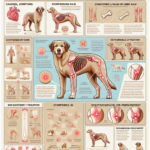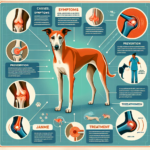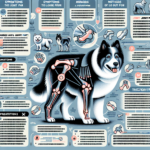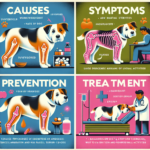Chesapeake Bay Retriever Joint Pain: Causes, Symptoms, Prevention, and Treatment

Introduction
The Chesapeake Bay Retriever, often affectionately called the “Chessie,” is a breed known for its intelligence, versatility, and robust physical capabilities. Originating from the Chesapeake Bay area in the United States, this breed was initially developed for retrieving waterfowl under harsh conditions. Chessies are characterized by their dense, waterproof coat, muscular build, and keen sense of smell. They are highly valued for their loyalty, endurance, and excellent swimming abilities.
Like many other breeds, Chesapeake Bay Retrievers are prone to certain health issues, with joint pain being a significant concern. Joint health is crucial for this breed due to their active lifestyle and the physical demands placed on them, whether they are working dogs or family pets. Understanding the causes, symptoms, prevention, and treatment of joint pain in Chesapeake Bay Retrievers is essential for ensuring their long-term health and well-being.
Breed-Specific Joint Pain Risks
Genetic Predisposition
Chesapeake Bay Retrievers have a genetic predisposition to several joint-related issues, including hip dysplasia, elbow dysplasia, and arthritis. Hip dysplasia is a condition where the hip joint does not fit into the hip socket properly, leading to pain and mobility issues. Elbow dysplasia involves abnormal development of the elbow joint, causing lameness and discomfort. Arthritis, a degenerative joint disease, can also affect Chessies, leading to chronic pain and stiffness.
Age-Related Risks
As Chesapeake Bay Retrievers age, the risk of developing joint pain increases. Typically, signs of joint issues may start to appear in middle age, around 5 to 7 years old. However, some dogs may show symptoms earlier, especially if they have a genetic predisposition or have experienced joint injuries. Senior Chessies, those over 8 years old, are particularly vulnerable to arthritis and other degenerative joint conditions.
Activity Level and Joint Stress
Chesapeake Bay Retrievers are known for their high energy levels and love for physical activities such as swimming, running, and retrieving. While regular exercise is essential for their overall health, excessive or high-impact activities can put significant stress on their joints. Working Chessies, in particular, may be at higher risk due to the demanding nature of their tasks. It’s crucial to balance their activity levels to prevent overexertion and joint damage.
Common Symptoms of Joint Pain in Chesapeake Bay Retrievers
General Symptoms
- Limping or favoring one leg
- Stiffness, especially after rest or sleep
- Reluctance to climb stairs or jump
- Decreased activity or playfulness
- Visible discomfort or pain when moving
- Swelling around the joints
- Changes in gait or posture
Breed-Specific Symptoms
In Chesapeake Bay Retrievers, joint pain may manifest more prominently due to their active nature. Owners might notice a decrease in their dog’s enthusiasm for activities they once enjoyed, such as swimming or retrieving. Additionally, Chessies may show signs of pain or discomfort after long periods of exercise or work, which can be more noticeable compared to less active breeds.
When to Consult a Vet
If you observe any of the above symptoms in your Chesapeake Bay Retriever, it’s essential to consult a veterinarian promptly. Early diagnosis and intervention can significantly improve the quality of life for dogs with joint pain. Persistent limping, noticeable pain, or any sudden changes in behavior or activity levels should be addressed by a professional to determine the underlying cause and appropriate treatment.
Preventive Measures for Joint Health
Exercise Recommendations
Regular, moderate exercise is crucial for maintaining joint health in Chesapeake Bay Retrievers. Activities such as swimming, which is low-impact and easy on the joints, are highly recommended. Avoid high-impact exercises like jumping or running on hard surfaces, which can exacerbate joint stress. Consistent, controlled exercise helps maintain muscle strength and joint flexibility without overburdening the joints.
Dietary Suggestions
A balanced diet rich in essential nutrients is vital for joint health. Consider incorporating foods or supplements that contain glucosamine, chondroitin, and omega-3 fatty acids, which support joint function and reduce inflammation. High-quality commercial dog foods formulated for large breeds often include these nutrients. Always consult your veterinarian before adding supplements to your dog’s diet.
Weight Management
Maintaining a healthy weight is one of the most effective ways to reduce joint stress in Chesapeake Bay Retrievers. Excess weight puts additional pressure on the joints, exacerbating pain and mobility issues. Regularly monitor your dog’s weight and adjust their diet and exercise routine as needed to keep them within a healthy weight range. Your veterinarian can provide specific guidelines based on your dog’s age, size, and activity level.
Early Screening and Monitoring
Early screening for joint issues can help catch problems before they become severe. Regular veterinary check-ups, including orthopedic evaluations, are essential for monitoring joint health. For Chesapeake Bay Retrievers, screening for hip and elbow dysplasia is particularly important. Early detection allows for timely intervention and management, potentially slowing the progression of joint diseases.
Treatment Options for Joint Pain
Non-Surgical Treatments
Non-surgical treatments for joint pain in Chesapeake Bay Retrievers include medications, physical therapy, and lifestyle adjustments. Anti-inflammatory drugs and pain relievers can help manage pain and reduce inflammation. Physical therapy, including exercises and massage, can improve joint mobility and strength. Lifestyle adjustments, such as providing a comfortable resting area and avoiding high-impact activities, can also alleviate joint stress.
Surgical Options
In severe cases of joint pain, surgical intervention may be necessary. Common surgical options for Chesapeake Bay Retrievers include hip replacement, arthroscopy, and joint fusion. Hip replacement involves replacing the damaged hip joint with an artificial one, providing significant pain relief and improved mobility. Arthroscopy is a minimally invasive procedure used to diagnose and treat joint issues. Joint fusion, or arthrodesis, involves fusing the bones in a joint to eliminate pain from movement. Your veterinarian will determine the most appropriate surgical option based on the severity and location of the joint issue.
Alternative Therapies
Alternative therapies can complement traditional treatments and provide additional relief for joint pain. Acupuncture, hydrotherapy, and massage are popular options for Chesapeake Bay Retrievers. Acupuncture involves inserting thin needles into specific points on the body to relieve pain and promote healing. Hydrotherapy, or water therapy, uses the buoyancy of water to reduce joint stress while allowing for gentle exercise. Massage therapy can improve circulation, reduce muscle tension, and alleviate pain. Always consult your veterinarian before starting any alternative therapy.
Lifestyle and Management Tips
Daily Care Routine
A consistent daily care routine can help manage and alleviate joint pain in Chesapeake Bay Retrievers. Start with a gentle morning walk to loosen stiff joints, followed by a balanced meal with joint-supporting nutrients. Incorporate low-impact activities like swimming or controlled play sessions throughout the day. Provide a comfortable resting area with an orthopedic bed to support their joints. End the day with a gentle massage or stretching exercises to relax the muscles and joints.
Modifying the Home Environment
Making your home more comfortable for a dog with joint pain can significantly improve their quality of life. Consider installing ramps to help them navigate stairs or get onto furniture without jumping. Provide an orthopedic bed with adequate support to reduce pressure on their joints. Ensure that food and water bowls are at a comfortable height to prevent strain on their neck and joints. Non-slip mats can also help prevent falls and provide better traction on slippery surfaces.
Long-Term Management
Long-term management of joint pain in Chesapeake Bay Retrievers involves a combination of regular veterinary care, appropriate exercise, a balanced diet, and a supportive home environment. Regular check-ups with your veterinarian are essential for monitoring joint health and adjusting treatment plans as needed. Consistent, low-impact exercise helps maintain joint mobility and muscle strength. A balanced diet with joint-supporting nutrients and maintaining a healthy weight are crucial for reducing joint stress. Providing a comfortable and supportive home environment ensures that your dog can live a happy and active life despite joint pain.
FAQs About Chesapeake Bay Retrievers and Joint Pain
What are the early signs of joint pain in Chesapeake Bay Retrievers?
Early signs of joint pain in Chesapeake Bay Retrievers include limping, stiffness, reluctance to move, decreased activity, and visible discomfort when moving. If you notice any of these symptoms, consult your veterinarian for a thorough evaluation.
Can joint pain in Chesapeake Bay Retrievers be prevented?
While genetic predispositions cannot be entirely prevented, you can take several measures to reduce the risk of joint pain in Chesapeake Bay Retrievers. These include maintaining a healthy weight, providing regular low-impact exercise, feeding a balanced diet with joint-supporting nutrients, and regular veterinary check-ups for early detection and intervention.
Are there specific exercises that are better for Chesapeake Bay Retrievers with joint pain?
Yes, low-impact exercises such as swimming and controlled walking are ideal for Chesapeake Bay Retrievers with joint pain. These activities help maintain joint mobility and muscle strength without putting excessive stress on the joints. Avoid high-impact activities like jumping or running on hard surfaces.
What dietary supplements can help with joint pain in Chesapeake Bay Retrievers?
Dietary supplements that can help with joint pain in Chesapeake Bay Retrievers include glucosamine, chondroitin, and omega-3 fatty acids. These supplements support joint health by reducing inflammation and promoting cartilage repair. Always consult your veterinarian before adding supplements to your dog’s diet.
When should I consider surgical options for my Chesapeake Bay Retriever’s joint pain?
Surgical options should be considered when non-surgical treatments are no longer effective in managing your dog’s joint pain, and their quality of life is significantly impacted. Your veterinarian will evaluate the severity of the joint issue and recommend the most appropriate surgical intervention based on your dog’s specific condition.
Conclusion
Joint pain is a common concern for Chesapeake Bay Retrievers, but with proper understanding and management, you can help your dog lead a comfortable and active life. By recognizing the causes and symptoms of joint pain, taking preventive measures, and exploring various treatment options, you can ensure your Chessie’s joint health and overall well-being. Regular veterinary check-ups and a supportive home environment are essential for long-term management. Remember, early intervention and consistent care are key to keeping your Chesapeake Bay Retriever happy and healthy.




